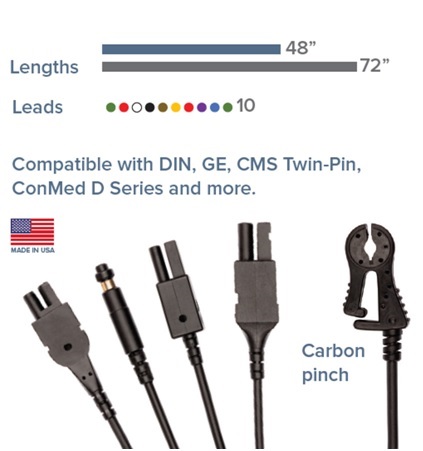High-quality medical equipment is a cornerstone of effective healthcare delivery. This is particularly true for electrocardiography (ECG) equipment, which plays a pivotal role in monitoring patients' heart activity.
In the world of ECG equipment, radiolucent leadwires stand out for their unique advantages.
Here at LifeSync, we’re a leading manufacturer of ECG equipment and other medical products, including a range of radiolucent leads that promise clear signals, superior trace quality, and unobstructed views for fast and accurate cardiac diagnostic and imaging results.
In this article, we will explore the evolution and significance of radiolucent technology and why it is so important in the field of Electrocardiography.
Understanding Radiolucent Technology
To fully appreciate the value of radiolucent leads, it's essential to understand what “radiolucent” means. In medical terms, “radiolucent” refers to materials or tissues that allow X-rays to pass through easily. Radiolucent objects do not block radiation but let it pass, resulting in black or near-black structures on conventional X-rays.
This quality is particularly valuable in the context of ECG leadwires, as it allows for clear imaging of the heart without the wires obstructing the view. In a field where even slight obstructions in X-ray views could potentially mean life or death for a patient, it’s easy to see the significance of this technology.
The use of the term “'radiolucent” in a medical context dates back to 1917, demonstrating the long history of this concept in healthcare. However, the application and technology of radiolucent materials have significantly evolved over the years, becoming far more widespread.
The Evolution of Radiolucent Technology
The history of radiology and the evolution of radiolucent technology are deeply intertwined. Radiology began with the discovery of X-rays by Wilhelm Roentgen in 1895. Roentgen's studies led to the discovery of invisible rays capable of passing through most substances and leaving shadows that could be recorded on photographic plates. These rays were later named "X-rays" due to their unknown nature at the time.
The earliest radiography involved recording images onto glass photographic plates. The next significant leap in radiographic imaging came in 1918 with the introduction of film by George Eastman, founder of the Eastman Kodak Company. Modern radiography utilizes digital imaging and archiving technology to record and store radiographic images electronically.
Over the years, technological advances have significantly shaped the landscape of medical imaging. From the propagation of ultrasound technology in the 1950s to the emergence of computed axial tomography (CAT) scans and magnetic resonance imaging (MRI) in the 1970s, the evolution of imaging methods has revolutionized patient care.
Radiolucent technology, with its ability to permit X-rays to pass through for unobstructed imaging, has been an integral part of this evolution. Today, radiolucent materials are used in various medical applications, including ECG leadwires, to enhance the clarity of diagnostic images and improve patient care outcomes.
Radiolucent vs. Radiopaque: Key Differences
The terms "radiolucent" and "radiopaque" are used to describe how different materials interact with radiation, such as X-rays, in medical imaging.
- As detailed above, radiolucent materials allow radiation to pass through them. In medical imaging, these areas appear dark or black because the radiation (such as X-rays) has passed through the material or tissue and reached the detector on the other side. Examples of radiolucent tissues in the body include air-filled lungs and areas with fat.
- Radiopaque materials, on the other hand, block or absorb radiation. In medical imaging, these areas appear white or light-colored because the radiation has not passed through; instead, it's been absorbed by the material or tissue. Examples of radiopaque tissues in the body include bones and areas with metal implants.
So, in essence, the difference between radiolucent and radiopaque materials lies in how they interact with radiation: radiolucent materials let radiation pass through, while radiopaque materials, such as traditional leadwires, block or absorb it.
The Future of ECG and Radiolucent Technology
Radiology has come a long way since its inception in the late 19th century, transforming from image production with glass photographic plates to high-resolution digital modalities that harness cutting-edge technologies. Radiolucent technology, as a part of this journey, has proven its worth by enhancing the clarity and accuracy of diagnostic imaging.

In ECG monitoring, the use of radiolucent leadwires has revolutionized cardiac imaging by providing unobstructed views of the heart.
With companies like ours leading the way in manufacturing high-quality radiolucent leads, the future of ECG monitoring looks promising. As we move forward, the continued evolution and application of radiolucent technology will undoubtedly play a vital role in advancing healthcare delivery and improving patient outcomes.
Our Radiolucent Leads: The Advantages
Radiolucent leadwires are designed to allow X-rays to pass through them without leaving a shadow on the image. LifeSync takes pride in manufacturing the only shielded radiolucent leadwires, which are specifically designed to offer superior results to that of traditional leadwires.
As part of LifeSync Cardiac, these radiolucent ECG lead wires contribute to our reputation as a dependable source for ECG monitoring equipment. Known for offering robust, cost-effective, and reliable solutions, LifeSync helps standardize patient monitoring across various medical settings.
Whether reusable or for single-patient use, LifeSync's radiolucent leadwire portfolio is unsurpassed in terms of ease, efficiency, and accuracy. With more than 60 configurations available, LifeSync offers the most comprehensive selection of radiolucent leadwires in the USA market, with a strong pinch grab to minimize alarms but at the same time easy-to-press all carbon pinch and lightweight leadwire, being more comfortable for patients as well, make us unbeatable in price and quality with a 100% made in USA product.
Is Radiolucent Technology Safe?
Radiolucent materials, such as certain types of plastic, are safe to use in a medical context because they allow X-rays and other forms of radiation to pass through them. This is beneficial because it prevents these materials from obscuring the images produced during radiological examinations, such as X-rays, CT scans, and floroscopies.
It's important to note that the safety of radiolucent technology, like any medical technology, heavily depends on how it is used. For example, while the material itself is safe, its application in a medical device (like an ECG leadwire) requires careful design and manufacturing to ensure that the device is safe for patient use, which is something we specialize in specifically. Similarly, while radiolucent materials don't interfere with imaging, the radiation used in imaging procedures can have potential risks, and healthcare providers must use appropriate safety measures to limit a patient's exposure to radiation.
Our ECG Monitoring Equipment at a Glance
Not only do we carry 5-lead and 10-lead radiolucent ecg leadwires, we feature a wide variety of other vital pieces of equipment under the umbrella of ECG monitoring.
We carry 3-lead ECG cables and 3-lead ECG molded cables, along with reusable ECG electrodes and ECG trunk cables as well. When it comes to high-quality ECG monitoring equipment, Lifesync Cardio is your go-to source. Contact us at 1-800-358-2468 for more information on the specific products we carry and how we can assist in fulfillment for your facility or medical practice.

